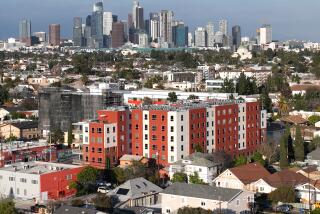Money Keeps Many Out of Suburbia
They gather at dawn, standing in small groups at bus stops or corners, waiting for their ride. Jesse Jackson sums up their working life in five words: “They take the early bus.”
They are the long-distance commuters of the working class, the thousands of city residents who haul themselves out to suburbia because that is the only place they can get a decent job.
Joyce Johnson, 50, lives in southeastern Atlanta and works as a clerk at a pharmacy in a shopping center north of the city. It’s a 40-minute drive, but Johnson doesn’t own a car. Instead, she has to take a two different buses because there is no direct service. She rises before dawn to catch the 6:30 a.m. bus to be sure of arriving on time for the store’s 8 a.m. opening.
Although the number of vehicles on the roads of Greater Atlanta has doubled in the last five years, commuting times have remained fairly constant because employers have moved closer to suburban residents.
“That don’t help me,” she sighed.
The older railroad suburbs had areas near the station where servants and other workers could live. But in an attempt to secure privacy and security in an increasingly dense suburban fabric, many of the expensive new residential communities and the most prosperous business centers are built out of reach of those most in need of housing and jobs.
Many new suburbs are designed to make sure that residents live only with other people like themselves. In a sort of residential dating service, developers and real-estate agents match elderly with elderly, singles with singles, families with families, tennis players with tennis players.
Because there is no place for the poor and inadequate public transportation, these communities lack hands to flip hamburgers, mow lawns, wash cars. This labor shortage is advertised in a million store windows: “Help Wanted.”
Some communities drop all pretenses of pluralism and resort to walls, gates and moats.
Last year, residents of Miami Shores, Fla., voted to raise property taxes to barricade the community to through traffic and, they hoped, criminals. An even more extreme example is Atlantis, a walled, gated and guarded community in Palm Beach County that hired a former Secret Service agent as its manager.
But money is the most effective barrier to suburbia; a single-family home is becoming so expensive that even the children of the middle class are finding admission prohibitive.
Suburbs designed to solve the housing problem now are part of it. When William Levitt began building the first of 17,000 houses on Long Island, N.Y., in 1948, the nation faced the worst housing shortage before or since.
GIs--men who saved the nation from Hitler, only to find themselves sleeping on in-laws’ couches, under cars and in chicken coops--lined up overnight to buy houses for $65 a month and nothing down.
Today, the federal subsidies that built Levittown are gone, and the town’s average house price (around $160,000) is low only in comparison to prices in other New York suburbs.
When Daphyne Rus and her family moved to Levittown in 1959, they were able to get a three-bedroom house with only $400 down. But when her own son was ready to move out years later, he had to rent a room from her for several years before he could afford a place of his own.
“Levittown was very good to us,” Daphyne Rus said. “I really feel for young people today. They need another Levitt.”
More to Read
Sign up for Essential California
The most important California stories and recommendations in your inbox every morning.
You may occasionally receive promotional content from the Los Angeles Times.










